South Asia: Finding trade options to boost regional economic ties
South Asian nations would see a bilateral advantage in establishing trade and economic relationships with each other and the formal association of economic cooperation - SAARC- which they have set up would gain strength by giving each other more trade access and tariff concessions to their goods and services, writes Partha Pratim Mitra for South Asia Monitor
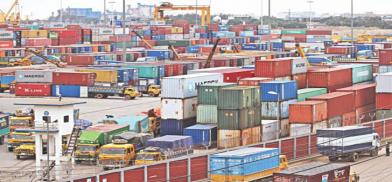
India and Bangladesh recently have stepped up their rail cooperation in mitigating the impact of the COVID-19 pandemic, as trade via land border faced disruptions. Rail as a cost-effective and environmental-friendly solution has helped in transporting essential commodities across the border. Both sides saw the highest ever exchange of freight trains in the month of June. A total of 103 freight trains were utilized for carrying essential commodities and raw materials. Parcel and container train services have also commenced between India and Bangladesh. This is expected to significantly enhance the scope of bilateral trade between the two countries.
There was recently an important development when the Indian Railways handed over 10 broad gauge locomotives to Bangladesh. These locomotives will help handle the increasing volume of passenger and freight train operations in Bangladesh.
Bangladesh – a bridge between South and Southeast Asia
Bangladesh, that is often mooted as a regional logistics and transit hub and which acts a bridge between South and Southeast Asia, shares a border of over 2,000 km with India and is home to major sea and land ports such as Mongla, Payra, Benapole, and Bhomra. It has also on its part taken steps to participate in this strategy. The upgrade of a 260 km highway from Bhomra in southwestern Bangladesh to Hatikumrul is expected to turn an old two-lane single carriageway into a state-of-the-art and climate-resilient four-lane dual carriageway. It should act as a fillip along with secondary and tertiary roads, logistics infrastructure in the form of storage, packaging facilities, and collection points to stimulate the local economy along with the Western Economic Corridor covering 10 districts of the country.
By connecting businesses and consumers through trade and consumption, and eventually generating higher income and new jobs, the refurbished highway is likely to bring a welcome economic boost to western Bangladesh, which lags behind the rest of the country. Since 2010, poverty has remained high in western Bangladesh while declining in the central and eastern divisions; consumption growth is also significantly lower than in other parts of Bangladesh.
Improving trade and economic relations between the two countries and the integration of the region through rail and road network is a part of what is often referred to as the Look East Policy (LEP), which has been India's major foreign policy initiative since the early 1990s. In the second half of 2014, LEP was upgraded to Act East Policy which focused on the extended neighbourhood in the Asia-Pacific region. The policy which was originally conceived as an economic initiative has been extended to include political, strategic and cultural dimensions and establishment of institutional mechanisms for dialogue and cooperation. The key principles and objectives of Act East Policy is to promote economic cooperation, cultural ties and develop a strategic relationship with countries in the Asia-Pacific region through continuous engagement at bilateral, regional and multilateral levels thereby providing enhanced connectivity to the states of the Northeast with countries in their neighbourhood.
In addition, various plans at bilateral and regional levels include steady efforts to develop and strengthen connectivity of Northeast with the ASEAN region through trade, culture, people-to-people contacts and physical infrastructure (road, airport, telecommunication, power, etc.). Some of the major projects include Kaladan Multi-Moda Transit Transport Project, the India-Myanmar-Thailand Trilateral Highway Project, Rhi-Tiddim Road Project, Border Haats, etc.
COVID-19 hits South Asian hard
Turning to world trade and trade of South Asian countries in the period before and immediately after the onset of COVID-19 pandemic, the trends show that the situation progressively deteriorated both globally and in South Asia between January 2020 and April 2020. Also seen was that the decline in exports and import compression was sharper in South Asia in comparison to the world trade and emerging and developing Asia in the month of April 2020 when lockdowns were observed in many countries across the world including South Asia in response to the pandemic. (See tables and figures 1 and 2)
Table 1: EXPORT(In million USD) :WORLD AND SOUTH ASIA
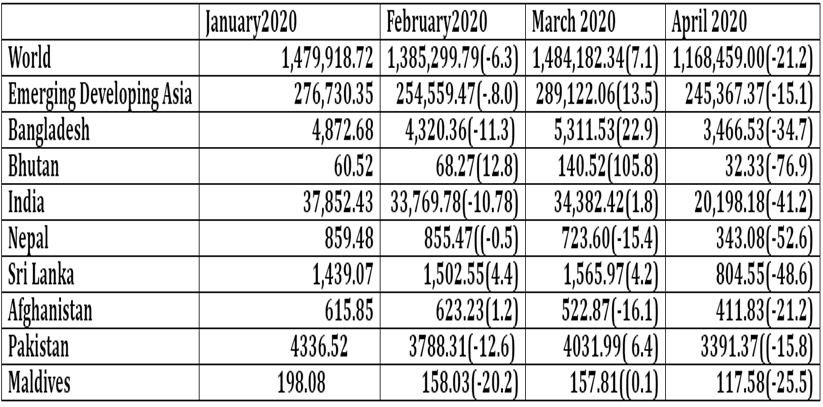
Note: Figures in brackets are percentage variation
Source: IMF, Direction of Trade Statistics,https://data.imf.org/
Figure 1:EXPORT(% VARIATION): WORLD AND SOUTH ASIA
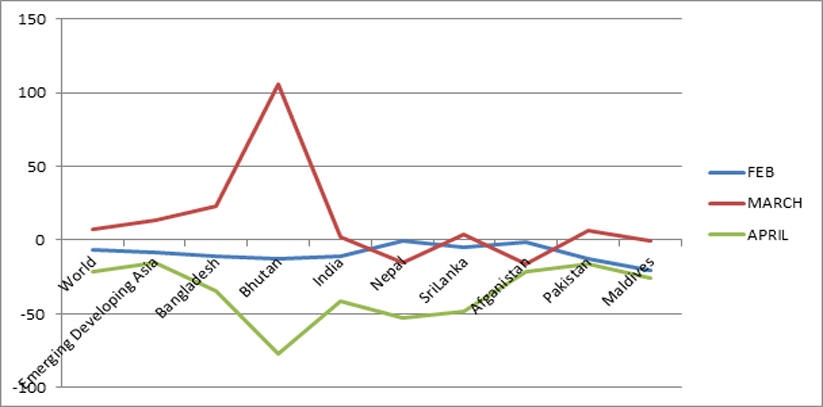
Source: IMF, Direction of Trade Statistics,https://data.imf.org/
Table 2-IMPORTS (In million USD): WORLD AND SOUTH ASIA
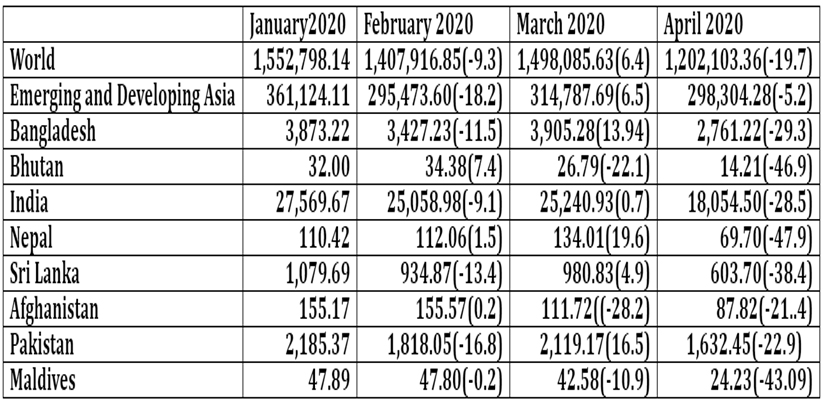
Note: Figures in brackets are percentage variation
Source: IMF, Direction of Trade Statistics, https://data.imf.org/
Figure 2:IMPORTS(% VARIATION): WORLD AND SOUTH ASIA
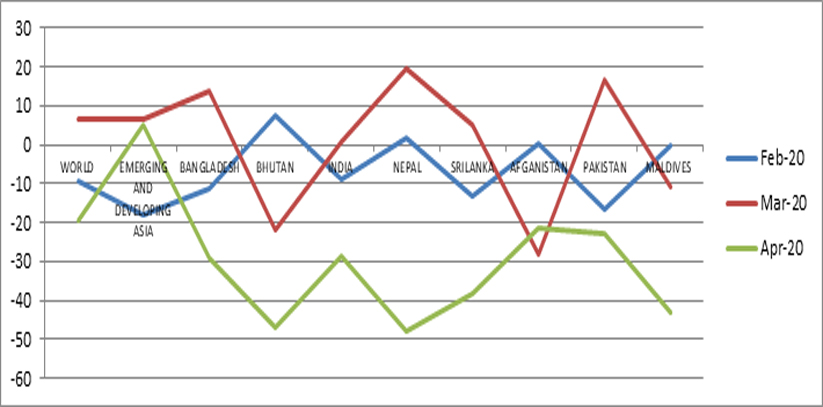
Source: IMF, Direction of Trade Statistics, https://data.imf.org/
While export declines and import compressions have become a feature of world trade, in South Asia, the past track record of intra-regional trade should not be the guiding factor for a collective effort to overcome the economic challenges posed by the pandemic. In 2019-20, only 0.8 percent of the overall goods imports to India came from the neighbouring countries, which declined from a peak of 1.8 percent which was achieved in 2001-02.
Estimates show that countries around the world harness the potential of intraregional trade to prosper together with their neighbors. However, while intraregional trade accounts for 50 percent of total trade in East Asia and the Pacific and 22 percent in Sub-Saharan Africa, it forms only 5 percent of South Asia’s total trade. Experience shows that countries in the region stand to gain from increasing trade cooperation. For example, for India, deeper regional trade and connectivity can reduce the isolation of Northeast India, give Indian firms better access to markets in South Asia and East Asia, and allow it to substitute fossil fuels by cleaner hydropower from Nepal and Bhutan.
Indian consumers will also gain from the availability of a greater variety of consumer goods at cheaper prices. Surveys done have confirmed that there has been a significant increase in the incomes of vendors in both Bangladesh and India and growth in livelihood opportunities for women and marginalized workers. For example, Indian laborers at the haats, earn one-third or more of their average monthly income from just four days of working at haats. Focus group discussions with stakeholders and interviews with Border Security Force personnel has shown that the haats have also led to a reduction in informal and illegal trading, and generated a peace dividend.
Another example is the progressive liberalization of India-Sri Lanka air services, which has improved connectivity, reduced airfares, and increased passenger traffic and air cargo volume. Indians and Sri Lankans have direct connections from Colombo to 14 Indian cities, with a total of about 147 flights per week. Since 2005, India has been one of the largest sources of foreign tourists in Sri Lanka.
Although the proximity of nations has been one of the important reasons for trade and economic cooperation, it has been found that these relations strengthen and improve either on a multilateral or bilateral basis if countries see the relationships to the mutual advantage of each other. In South Asia, countries have been part of a common economic and political framework of the erstwhile British empire and after achieving freedom have retained their economic and cultural links with the West.
These old links have also fostered trade relations and therefore South Asian nations continue to trade more with the West rather than with themselves. As the COVID-19 pandemic makes trading with the West difficult and as more opportunities in the region has opened up, South Asian nations would see a bilateral advantage in establishing trade and economic relationships with each other and the formal association of economic cooperation - SAARC- which they have set up would gain strength by giving each other more trade access and tariff concessions to their goods and services.
(The writer is a retired Indian Economic Service officer who worked in the labour ministry. The views expressed are personal. He can be contacted at ppmitra56@gmail.com)
References:
https://www.pib.gov.in.pib .nic.in July 27, 2020
ibid
Rajesh Rohatgi et al , Western Bangladesh can become a transit hub in South Asia
JUNE 26, 2020 https://blogs.worldbank.org/endpovertyinsouthasia/western-bangladesh-can-become-transit-hub-south-asia
LOK SABHA UNSTARRED QUESTION NO. 3121
ANSWERED ON 16.03.2016
https://mea.gov.in/lok-sabha/26554/QUESTION_NO_3121_LOOK_EAST_AND_ACT_EAST_POLICY
Vivek Kaul https://www.livemint.com/news/india/india-s-trade-with-neighbours-has-largely-been-flat-11597158241853.html : 11 Aug 2020,
Sanjay Kathuria (Ed)2018,A Glass Half Full: The Promise of Regional Trade in South
Asia, https://openknowledge.worldbank.org/bitstream/handle/10986/30
Also see https://www.worldbank.org/en/news/press-release/2018/09/24/south-asia-remove-trade-barriers-mutual-economic-gains-report









Post a Comment